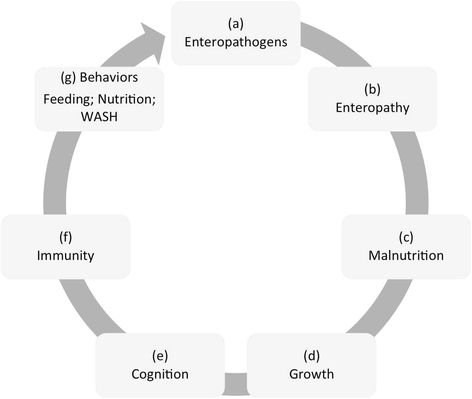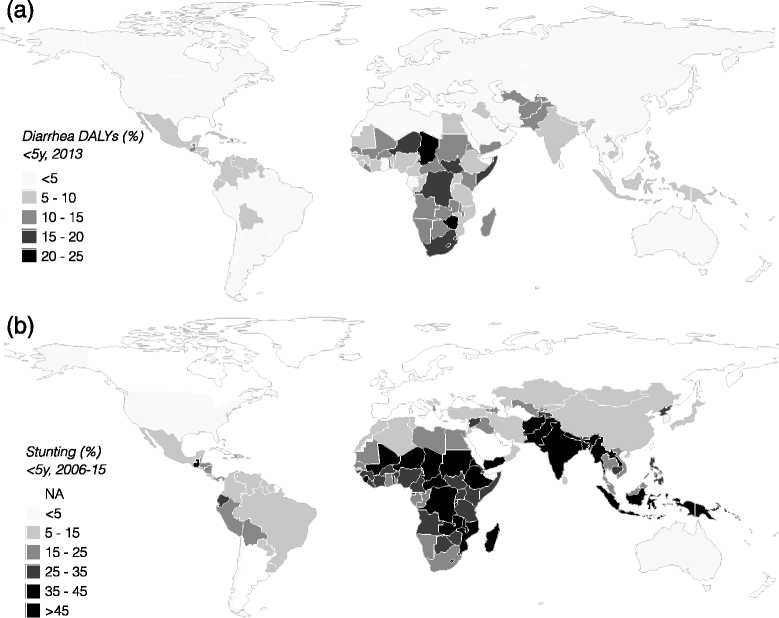Diarrheal disease and enteric infections in LMIC communities: how big is the problem?
- PMID: 28883955
- PMCID: PMC5531018
- DOI: 10.1186/s40794-016-0028-7
Diarrheal disease and enteric infections in LMIC communities: how big is the problem?
Abstract
Studies of enteric diseases have historically focused on observations of clinical diarrhea as a cause of mortality and morbidity. Emerging evidence suggests that diarrhea dramatically underestimates both exposure to enteropathogens and the long-term consequences arising from infection. High burden of pathogens in the gut, even in the absence of diarrhea, is common in infants in low and middle income countries. Continual challenge by pathogens, in conjunction with an inadequate diet stimulates an inflammatory disease that alters the structure of the gut, metabolic and immunological pathways and changes the microbiome. Both diarrhea and enteropathogen infection have been associated with reduced growth, reduced cognitive development, and reduced vaccine efficacy suggesting that the burden of diarrheal disease is dramatically underestimated.
Keywords: Cognitive development; Diarrhea; Enteric pathogens; Enteropathy; Growth; Malnutrition; Sanitation and hygiene; Vaccine response.
Figures


Similar articles
-
Methods of analysis of enteropathogen infection in the MAL-ED Cohort Study.Clin Infect Dis. 2014 Nov 1;59 Suppl 4(Suppl 4):S233-8. doi: 10.1093/cid/ciu408. Clin Infect Dis. 2014. PMID: 25305292 Free PMC article.
-
The MAL-ED study: a multinational and multidisciplinary approach to understand the relationship between enteric pathogens, malnutrition, gut physiology, physical growth, cognitive development, and immune responses in infants and children up to 2 years of age in resource-poor environments.Clin Infect Dis. 2014 Nov 1;59 Suppl 4:S193-206. doi: 10.1093/cid/ciu653. Clin Infect Dis. 2014. PMID: 25305287
-
Causal Pathways from Enteropathogens to Environmental Enteropathy: Findings from the MAL-ED Birth Cohort Study.EBioMedicine. 2017 Apr;18:109-117. doi: 10.1016/j.ebiom.2017.02.024. Epub 2017 Mar 8. EBioMedicine. 2017. PMID: 28396264 Free PMC article.
-
Disentangling Microbial Mediators of Malnutrition: Modeling Environmental Enteric Dysfunction.Cell Mol Gastroenterol Hepatol. 2019;7(3):692-707. doi: 10.1016/j.jcmgh.2018.12.006. Epub 2019 Jan 7. Cell Mol Gastroenterol Hepatol. 2019. PMID: 30630118 Free PMC article. Review.
-
Dynamic of the human gut microbiome under infectious diarrhea.Curr Opin Microbiol. 2022 Apr;66:79-85. doi: 10.1016/j.mib.2022.01.006. Epub 2022 Feb 1. Curr Opin Microbiol. 2022. PMID: 35121284 Free PMC article. Review.
Cited by
-
A Historical Review on Antibiotic Resistance of Foodborne Campylobacter.Front Microbiol. 2019 Jul 26;10:1509. doi: 10.3389/fmicb.2019.01509. eCollection 2019. Front Microbiol. 2019. PMID: 31402900 Free PMC article. Review.
-
Exploring behavioural factors affecting nutritional supplement use among children in Honduras.Public Health Nutr. 2022 Feb;25(2):323-331. doi: 10.1017/S1368980021004468. Epub 2021 Oct 28. Public Health Nutr. 2022. PMID: 34706788 Free PMC article.
-
Antibiotics for acute watery or persistent with or without bloody diarrhoea in children: A systematic review and meta-analysis.J Glob Health. 2024 Dec 6;14:04211. doi: 10.7189/jogh.14.04211. J Glob Health. 2024. PMID: 39641317 Free PMC article.
-
Magnitude of enteric pathogens associated with diarrhea and antibiotic resistance of enteric bacterial pathogens isolated among children under 5 years of age in Bule Hora town, West Guji, Ethiopia.Front Public Health. 2024 Oct 7;12:1398264. doi: 10.3389/fpubh.2024.1398264. eCollection 2024. Front Public Health. 2024. PMID: 39435410 Free PMC article.
-
Growth faltering regardless of chronic diarrhea is associated with mucosal immune dysfunction and microbial dysbiosis in the gut lumen.Mucosal Immunol. 2021 Sep;14(5):1113-1126. doi: 10.1038/s41385-021-00418-2. Epub 2021 Jun 22. Mucosal Immunol. 2021. PMID: 34158595 Free PMC article.
References
-
- Scrimshaw NS, Taylor CE, Gordon JE. Interactions of nutrition and infection. Monogr Ser World Health Organ. 1968;57:3–329. - PubMed
-
- Mata LJ, Urrutia JJ, Gordon JE. Diarrhoeal disease in a cohort of Guatemalan village children observed from birth to age two years. Trop Geogr Med. 1967;19:247–57. - PubMed
-
- Sedgwick WT, Macnutt JS. On the Mills-Reincke Phenomenon and Hazen’s Theorem concerning the decrease in mortality from diseases other than typhoid fever following the purification of public water-supplies. J Infect Dis. 1910;7:489–564. doi: 10.1093/infdis/7.4.489. - DOI
Publication types
LinkOut - more resources
Full Text Sources
Other Literature Sources

